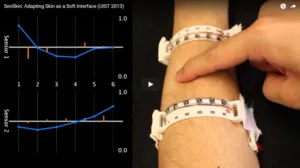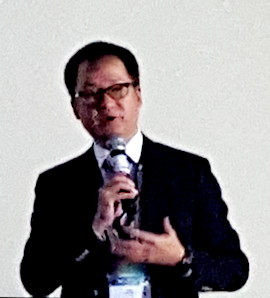 Masahiko Inami – University of Tokyo – gave an intriguing talk. As it turned out, little of it was really related to displays, but it was intriguing. Inami has previously worked at Keio University and has also worked at science museum and he now works at the Living Lab in Tokyo where he is working on “superhuman sports”
Masahiko Inami – University of Tokyo – gave an intriguing talk. As it turned out, little of it was really related to displays, but it was intriguing. Inami has previously worked at Keio University and has also worked at science museum and he now works at the Living Lab in Tokyo where he is working on “superhuman sports”
Inami has done a lot of work on input and touch including a ‘Sens Skin’ UIST2013 application that allows someone to use their wrist for a touch panel – useful because the wrist gives ‘natural haptic feedback’. Check www.masaogata.com for details of that project. He also developed a multi-touch steering wheel and a system for using focused ultrasound to draw patterns on fur, fabrics or carpets.
He showed an application for smart eyewear, which detects eye movement and blink using electrodes on the sides of the nose. In playing a game, tracking the eye movement means you can analyse activity. The sensors can also be used to track the user’s expression – and can be used for analysis or for reflecting facial expressions to an avatar in virtual games.
The idea of augmenting human capabilities led to the question “How can you use technology for creating superheros?”. Inami had worked on telerobotics and developed an idea of ‘XRay vision’ based on the concept of optical camouflage back in 2003. The system used a camera to look behind the user and project an image from behind onto the front of the user or an object that was blocking the view. The same concept was also developed for the interior of car. In this case, there was a projection of the outside world on the inside of the car, making the car, effectively transparent from the inside point of view. This is particularly useful in situations where, for example, the car is reversing. Inami said that one of the challenges is having surfaces that are reflective enough on the seats.
Inami said that this is a kind of ‘super human power’. As long ago as 1665, Robert Hooke in his micrographia suggested that microscopy enhanced visual power using optics and was like “Adding organs”.
Inami was involved with the Sens Skin project
There is more you can do an Inami talked about using fast exposures and ‘stop-motion photography’ so that high speed motion can be seen very clearly. In many cases, it pays to ask “where is the bottleneck of our behaviour?”. If we improve vision, we can improve performance. Inami said that he has developed the idea of “Spider vision” – where AR glasses mean that you can see a front and back view at the same time (http://ahlab.org/project/spidervision). This takes some practice and he showed a video of a student spotting that someone was trying to steal an item behind the viewer.
His group has done work developing ‘robot hands’ that can be controlled by the feet. He showed a very cool demonstration of someone learning to solder with the robot arms controlled by the legs, while the workpiece was held in two hands! M4A metamorphosis.
In 2020 Tokyo will host the Olympics and as part of the build up, Inami has been working on ‘Superhuman sports’ ( superhuman-sports.org) in 2015, he founded a sports society which now has many members. He is enjoying inventing new sports using technology. Some he showed are bizarre, like playing golf with an earth-moving digger and a very big ball. Other superhuman sports include running with blades (like those used by paraolympians) as well as “extreme crutch” racing and HADO. Now, Inami said, there are more than 10,000 superhuman sports players. He is also running workshops to develop sports. Another sport is ‘Slidrift’ which uses small wheels all around the wheels of an electric wheel chair and that allows ‘drifting’. Other sports include ‘Hover Crosse’ which is like lacrosse, but on hover boards.
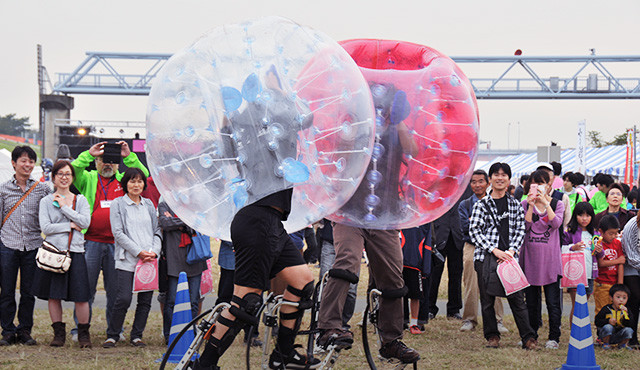 Bubble jumping is one of the new ‘Superhuman’ sports
Bubble jumping is one of the new ‘Superhuman’ sports
University of Tokyo is now developing these sports at an institute. Now the group is internationalising its activities and presented at the Augmented Human conference in San Jose – this month. Inami would like one or more of the sports to be new sports for the olympics. The aim of the technologies is to be as inclusive as possible, allowing old people, for example, to take part. There should not be a ‘unified human image’, he said – thanks to technology everybody can enjoy sport. He also believes that like Formula 1, where advanced technologies are tested, extreme sports could be used to develop technologies that may then be useful in everyday life. Advanced technologies should help all developments.
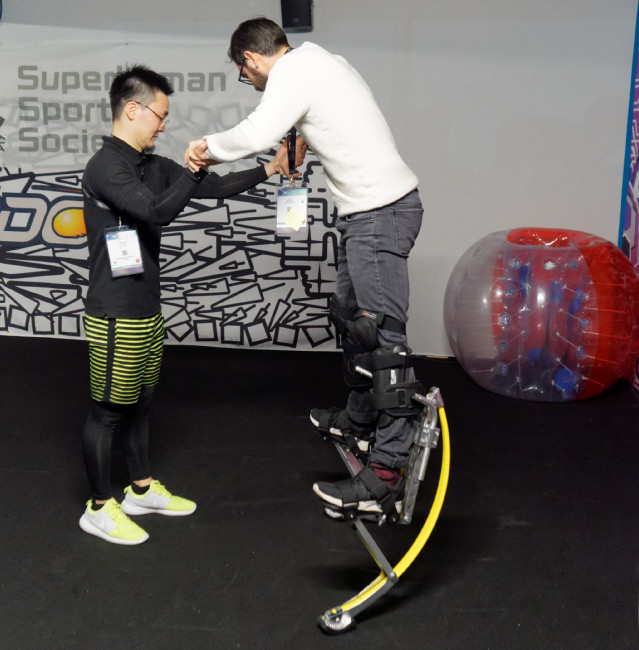 Jumpers for bubble jumping. Image:Meko
Jumpers for bubble jumping. Image:Meko 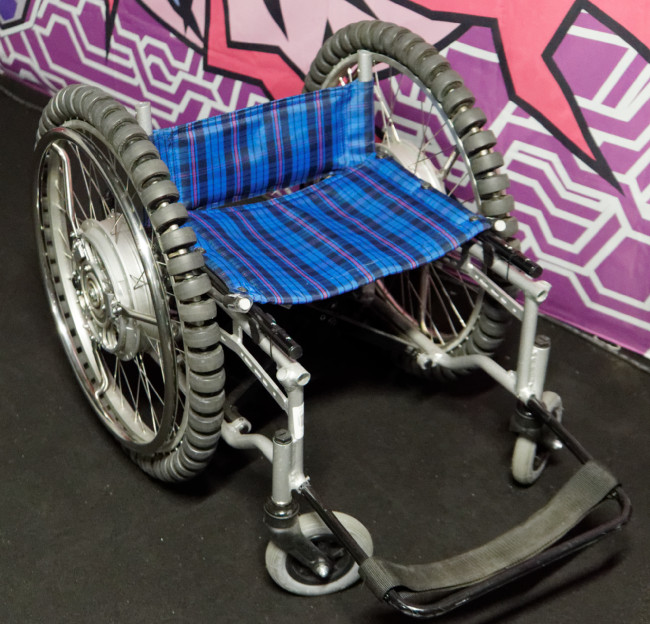 Wheelchair for ‘drifting’. Image:Meko
Wheelchair for ‘drifting’. Image:Meko

